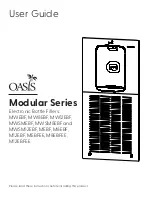
Chapter 5
Utilities
5-4
ni.com
After this last transformation, and with
it follows that
and
By combining the transformation yielding the real ordered Schur form for
A with the transformation defined using X, the overall transformation T is
readily identified. In case all eigenvalues of A are stable or all are unstable,
this is flagged, and T = I.
stable( )
can be combined with a reduction algorithm such as
redschur( )
or
balmoore( )
to reduce the order of a system with some
unstable and some stable poles. One uses
stable( )
to separate the stable
and unstable parts, and then, for example, reduces the stable part with
redschur( )
; the reduced stable part is added to the original unstable part
to provide the desired system reduction.
Related Functions
sylvester()
,
schur()
,
redschur()
,
balmoore()
compare( )
[respdiff] = compare(Sys,SysRed,FTvec,{Fmin,Fmax,npts,radians,type})
The
compare( )
function provides a number of different graphical tests
which can be used to compare two state-space system implementations.
compare( )
can be used as a tool for evaluating a reduced-order system
by comparing it with the original full-order system from which it was
obtained. However, it can be used for more general comparisons as well,
such as examining the results of different discretization or identification
techniques.
B
B
S
B
U
=
C
C
S
C
U
[
]
=
SysS
A
S
A
S
C
S
D
;
[
,
]
=
SysU
A
U
B
U
C
U
0
;
[
,
]
=
















































